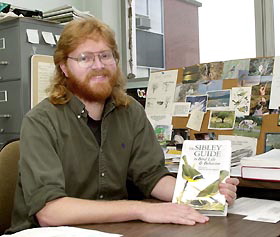|
This is an archived article.
For the latest news, go to the Advance
Homepage
For more archives, go to the Advance Archive/Search Page. | ||
|
Biologist's Bird Behavior Book
Wings its Way up Best-Seller List David Sibley and Chris Elphick had seen all the bird books before. Indeed, each has collaborated or contributed to several. But none was the type of volume people could sit down and read, like a good, thick novel. Thus was born The Sibley Guide to Bird Life and Behavior, a very thick volume that not only identifies bird types, habitats, sizes and shapes, but explains their habits, rituals, tendencies and even love life.
"Other bird books give you factual information about North American birds, but they're like a dictionary. We wanted to create essays on each family, each group of birds." The trio have developed a volume that explains why chickadees only take one seed at a time from bird feeders (they're storing the seeds for winter), how cardinals can survive New England summers and winters (they fluff their feathers for heat in winter, and pull them close to their body to remain cool in the summer), and why cormorants assume a Star Wars-like pose after they dive for fish (they are, simply, drying off). The book is filled with beautiful drawings of birds, painted by Sibley, whom Elphick calls "one of the best bird artists in the world," and 80 chapters of essays and discussion, one on each bird family - from loons to old world sparrows. A more than 120-page introduction, much of it written by Margaret Rubega, an assistant professor of ecology and evolutionary biology at UConn and the Connecticut State Ornithologist (she is also Elphick's wife), discusses how birds fly, breathe, eat, and behave. It explains the origin of the species, their distribution in North America, and conservation threats. Another chapter, on tyrant flycatchers, was written by George Clark, an emeritus professor of ecology and evolutionary biology at UConn and a former state ornithologist. The formula works. Since its introduction Oct. 2, the book has been a staple on Amazon.com's top 100 best titles list, climbing as high as 19th. The publishers, Alfred A. Knopf, have so much faith in it they ordered an initial run of 100,000 books, a huge number for a book not written by John Grisham or Steven King. Elphick and Rubega have known Sibley and his wife, Joan Walsh, for more than a decade. Rubega and Walsh, in fact, were friends in college. Elphick says the book is a companion to Sibley's first volume, a field guide to birds similar to what most people are familiar with. When they sat down to plot a book on bird behavior, however, they were looking for something different, he says. "This was written for the general public, but we didn't want to dumb it down," he says. "We wanted to explain the concepts in layman's terms, although it can also be used as a text. But it's aimed at the popular market." Judging by the book's sales, it appears the group has hit its mark. Richard Veilleux |

